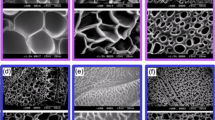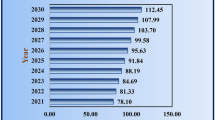Abstract
Ultrathin polymeric films may completely change in their surface properties from bacteria loving to bacteria repelling which are essential for creating non-fouling surfaces. The covalent modifications of biodegradable polylactide (PLA) surface with alkyl bromide initiator followed by immobilization of three different types of polymers having potential antibacterial effects, i.e., poly(2-hydroxyethyl methacrylate) (PHEMA), Poly(2-[(methacryloyloxy)ethyl]trimethylammonium chloride) (PMETA) and poly(poly(ethylene glycol) methacrylate) (PPEGMA) were successfully conducted using surface-initiated atom transfer radical polymerization (ATRP) technique. High initiator density (1.72 initiator/nm2) on PLA surface determined by XPS led to the formation of smooth polymer brush as shown by AFM images which were further characterized by FTIR and contact angle measurement. Though linear brush growth was observed irrespective of monomers employed, ‘grafting yield’ was found to be highest for PHEMA brush (22.2 µg cm−2 at 6 h) under similar conditions indicating its high activity in the presence of efficient catalytic system. Finally, the antibacterial response of these brushes was evaluated against both gram-positive (Staphylococcus aureus) and gram-negative (Escherichia coli) bacteria and PMETA modified PLA surface was found to exhibit the highest inhibition of bacterial adhesion (> 97% for S. aureus). The novelty lies in the generation of polymer brushes with excellent antibacterial property onto biodegradable polylactide surface. The potential uses of these modified surfaces would include biomedical devices, food packaging, etc.








Similar content being viewed by others
References
Lee SB, Koepsel RR, Morley SW, Matyjaszewski K, Sun Y, Russell AJ (2004) Permanent, nonleaching antibacterial surfaces. 1. Synthesis by atom transfer radical polymerization. Biomacromol 5:877–882
Patel MB, Patel SA, Ray A, Patel RM (2003) Synthesis, characterization, and antimicrobial activity of acrylic copolymers. J Appl Polym Sci 89:895–900
Seymour RB, Porter RS (eds) (1993) Manmade fibers: their origin and development. Elsevier, London, New York
Ranucci E, Ferruti P (1991) New basic multifunctional polymers: 5. Poly(esterthioetheramine)s by polyaddition of 2,2′-alkylenediimino diethanethiols to bisacrylic and bismethacrylic esters. Polymer 32:2876–2879
Darouiche RO (2004) Treatment of infections associated with surgical implants. N Engl J Med 350:1422–1429
Knetsch MLW, Koole LH (2011) New strategies in the development of antimicrobial coatings: the example of increasing usage of silver and silver nanoparticles. Polymers 3:340–366
Biswal AK, Saha S (2019) Prolonging food shelf-life by dual actives release from multi-layered polymer particles. Colloid Surf B Biointerf 175:281–290
Biswal AK, Usmani M, Ahammad SZ, Saha S (2018) Unveiling the slow release behavior of hollow particles with prolonged antibacterial activity. J Mater Sci 53:5942–5957
Campoccia D, Montanaro L, Arciola CR (2013) A review of the clinical implications of anti-infective biomaterials and infection-resistant surfaces. Biomaterials 34:8018–8029
Lakes AL, Peyyala R, Ebersole JL, Puleo DA, Hilt JZ, Dziubla TD (2014) Synthesis and characterization of an antibacterial hydrogel containing covalently bound Vancomycin. Biomacromolecules 15:3009–3018
Engler AC, Wiradharma N, Ong ZY, Coady DJ, Hedrick JL, Yang Y-Y (2012) Emerging trends in macromolecular antimicrobials to fight multi-drug-resistant infections. Nano Today 7:201–222
Fu Y, Yang Y, Xiao S, Zhang L, Huang L, Chen F, Fan P, Zhong M, Tan J, Yang J (2019) Mixed polymer brushes with integrated antibacterial and antifouling properties. Prog Org Coat 130:75–82
Chen T, Yang H, Wu X, Yu D, Ma A, He X, Sun K, Wang J (2019) Ultrahighly charged amphiphilic polymer brushes with super-antibacterial and self-cleaning capabilities. Langmuir 35:3031–3037
Valencia L, Kumar S, Jalvo B, Mautner A, Salazar-Alvarez G, Mathew AP (2018) Fully bio-based zwitterionic membranes with superior antifouling and antibacterial properties prepared via surface-initiated free-radical polymerization of poly(cysteine methacrylate). J Mater Chem A 6:16361–16370
Hadjesfandiari N, Yu K, Mei Y, Kizhakkedathu JN (2014) Polymer brush-based approaches for the development of infection-resistant surfaces. J Mater Chem B 2:4968–4978
Smith RS, Zhang Z, Bouchard M, Li J, Lapp HS, Brotske GR, Lucchino DL, Weaver D, Roth LA, Coury A, Biggerstaff J, Sukavaneshvar S, Langer R, Loose C (2012) Vascular catheters with a nonleaching poly-sulfobetaine surface modification reduce thrombus formation and microbial attachment. Sci Translat Med 4:153ra132
Yang WJ, Cai T, Neoh K-G, Kang E-T, Teo SL-M, Rittschof D (2013) Barnacle cement as surface anchor for “Clicking” of antifouling and antimicrobial polymer brushes on stainless steel. Biomacromolecules 14:2041–2051
Lenoir S, Pagnoulle C, Galleni M, Compère P, Jérôme R, Detrembleur C (2006) Polyolefin matrixes with permanent antibacterial activity: preparation, antibacterial activity, and action mode of the active species. Biomacromolecules 7:2291–2296
Kanazawa A, Ikeda T, Endo T (1994) Polymeric phosphonium salts as a novel class of cationic biocides. VI. Antibacterial activity of fibers surface-treated with phosphonium salts containing trimethoxysilane groups. J Appl Polym Sci 52:641–647
Gettings RL, White WC (1987) Progress in the application of a surface-bonded antimicrobial agent. Dow Corning Corp, Midland
Hüttinger KJ (1988) Fouling science and technology. A novel possibility to prevent biofouling. Springer, Dordrecht
Lewis K, Klibanov AM (2005) Surpassing nature: rational design of sterile-surface materials. Trends Biotechnol 23:343–348
Fu Y, Wang Y, Huang L, Xiao S, Chen F, Fan P, Zhong M, Tan J, Yang J (2018) Salt-responsive “Killing and Release” antibacterial surfaces of mixed polymer brushes. Indust Eng Chem Res 57:8938–8945
Han C, Li H, Pu H, Yu H, Deng L, Huang S, Luo Y (2013) Mesoporous alumina, synthesized by combining the three-block. Chem Eng J (Amsterdam, The Netherlands), Elsevier BV
Gao G, Lange D, Hilpert K, Kindrachuk J, Zou Y, Cheng JT, Kazemzadeh-Narbat M, Yu K, Wang R, Straus SK, Brooks DE, Chew BH, Hancock RE, Kizhakkedathu JN (2011) The biocompatibility and biofilm resistance of implant coatings based on hydrophilic polymer brushes conjugated with antimicrobial peptides. Biomaterials 32:3899–3909
Gao G, Yu K, Kindrachuk J, Brooks DE, Hancock RE, Kizhakkedathu JN (2011) Antibacterial surfaces based on polymer brushes: investigation on the influence of brush properties on antimicrobial peptide immobilization and antimicrobial activity. Biomacromolecules 12:3715–3727
Vert M, Li SM, Spenlehauer G, Guerin P (1992) Bioresorbability and biocompatibility of aliphatic polyesters. J Mater Sci-Mater Med 3:432–446
Vert M, Schwarch G, Coudane J (1995) Present and future of Pla polymers. J Macromol Sci-Pure Appl Chem A 32:787–796
Xu FJ, Wang ZH, Yang WT (2010) Surface functionalization of polycaprolactone films via surface-initiated atom transfer radical polymerization for covalently coupling cell-adhesive biomolecules. Biomaterials 31:3139–3147
Xu FJ, Yang XC, Li CY, Yang WT (2011) Functionalized polylactide film surfaces via surface-initiated ATRP. Macromolecules 44:2371–2377
Xu LQ, Pranantyo D, Neoh K-G, Kang E-T, Teo SL-M, Fu GD (2016) Synthesis of catechol and zwitterion-bifunctionalized poly(ethylene glycol) for the construction of antifouling surfaces. Polym Chem 7:493–501
Larkin P (2011) General outline and strategies for IR and raman spectral interpretation. In: Larkin P (ed) Infrared and Raman Spectroscopy, 7th edn. Elsevier, Oxford, pp 117–133
Mishra V, Kumar R (2011) Synthesis and characterization of five-arms star polymer of N-vinyl pyrrolidone through ATRP based on glucose. Carbohydr Polym 83:1534–1540
Moulder JF, Stickle WF, Sobol PE, Bomben KD (1992) In X-ray photoelectron spectroscopy. In: Chastain J (ed) Eden Prairie, p 43
Xing Z-C, Meng W, Yuan J, Moon S, Jeong Y, Kang I-K (2012) In vitro assessment of antibacterial activity and cytocompatibility of Quercetin-containing PLGA nanofibrous scaffolds for tissue engineering. J Nanomater 2012:1–7
Yang WJ, Cai T, Neoh K-G, Kang E-T, Dickinson GH, Teo SL-M, Rittschof D (2011) Biomimetic anchors for antifouling and antibacterial polymer brushes on stainless steel. Langmuir 27:7065–7076
Ignatova M, Manolova N, Rashkov I (2007) Novel antibacterial fibers of quaternized chitosan and poly(vinyl pyrrolidone) prepared by electrospinning. Eur Polym J 43:1112–1122
Ignatova M, Petkova Z, Manolova N, Markova N, Rashkov I (2012) Non-woven fibrous materials with antibacterial properties prepared by tailored attachment of quaternized chitosan to electrospun mats from maleic anhydride copolymer. Macromol Biosci 12:104–115
Ignatova M, Starbova K, Markova N, Manolova N, Rashkov I (2006) Electrospun nano-fibre mats with antibacterial properties from quaternised chitosan and poly(vinyl alcohol). Carbohydr Res 341:2098–2107
Serrano A, Sterner O, Mieszkin S, Zurcher S, Tosatti S, Callow ME, Callow JA, Spencer ND (2013) Nonfouling response of hydrophilic uncharged polymers. Adv Funct Mater 23:5706–5718
Krishnamoorthy M, Hakobyan S, Ramstedt M, Gautrot JE (2014) Surface-initiated polymer brushes in the biomedical field: applications in membrane science, biosensing, cell culture, regenerative medicine and antibacterial coatings. Chem Rev 114:10976–11026
Matyjaszewski K (2012) Atom transfer radical polymerization (ATRP): current status and future perspectives. Macromolecules 45:4015–4039
Matyjaszewski K, Xia J (2001) Atom transfer radical polymerization. Chem Rev 101:2921–2990
Siegwart DJ, Oh JK, Matyjaszewski K (2012) ATRP in the design of functional materials for biomedical applications. Prog Polym Sci 37:18–37
Shah RR, Merreceyes D, Husemann M, Rees I, Abbott NL, Hawker CJ, Hedrick JL (2000) Using atom transfer radical polymerization to amplify monolayers of initiators patterned by microcontact printing into polymer brushes for pattern transfer. Macromolecules 33:597–605
Xu FJ, Zhao JP, Kang ET, Neoh KG (2007) Surface functionalization of polyimide films via chloromethylation and surface-initiated atom transfer radical polymerization. Indust Eng Chem Res 46:4866–4873
Munirasu S, Dhamodharan R (2004) Very rapid copper-mediated atom transfer radical polymerization of benzyl methacrylate at ambient temperature. J Polym Sci Part A Polym Chem 42:1053–1057
Chatterjee DP, Chatterjee U, Mandal BM (2004) Atom transfer radical polymerization of methyl methacrylate at ambient temperature using soluble Cu(I) complex catalysts formed with mixed ligands of multidentate amines and halide ions. J Polym Sci Part A Polym Chem 42:4132–4142
Saha S, Baker GL (2007) Substituent effects in ATRP of polystyrene brushes. Am Chem Soc Div Polym Chem 48:783
Saha S, Bruening ML, Baker GL (2012) Surface-initiated polymerization of azidopropyl methacrylate and its film elaboration via click chemistry. Macromolecules 45:9063–9069
Saha S, Copic D, Bhaskar S, Clay N, Donini A, Hart AJ, Lahann J (2012) Chemically controlled bending of compositionally anisotropic microcylinders. Angew Chem Int Ed 51:660–665
Manecka GM, Labrash J, Rouxel O, Dubot P, Lalevée J, Andaloussi SA, Renard E, Langlois V, Versace DL (2014) Green photoinduced modification of natural poly(3-hydroxybutyrate-co-3-hydroxyvalerate) surface for antibacterial applications. ACS Sustain Chem Eng 2:996–1006
Al-Ani A, Pingle H, Reynolds NP, Wang PY, Kingshott P (2017) Tuning the density of poly(ethylene glycol) chains to control Mammalian cell and bacterial attachment. Polymers 9:343
Zhang C, Kuai Y, Cheng H, Liu X, Ma L (2017) Covalent bonding of grafted polymer brushes of poly(poly(ethylene glycol) monomethacrylate) on surface of silicon quantum dots and the activation of the end hydroxyls. In press, Arab J Chem
El Habnouni S, Darcos V, Garric X, Lavigne J-P, Nottelet B, Coudane J (2011) Mild methodology for the versatile chemical modification of polylactide surfaces: original combination of anionic and click chemistry for biomedical applications. Adv Funct Mater 21:3321–3330
Tan KL, Woon LL, Wong HK, Kang ET, Neoh KG (1993) Surface modification of plasma-pretreated poly(tetrafluoroethylene) films by graft copolymerization. Macromolecules 26:2832–2836
Wang X, Tu H, Braun PV, Bohn PW (2006) Length scale heterogeneity in lateral gradients of poly(N-isopropylacrylamide) polymer brushes prepared by surface-initiated atom transfer radical polymerization coupled with in-plane electrochemical potential gradients. Langmuir 22:817–823
Sui X, Zapotoczny S, Benetti EM, Schön P, Vancso GJ (2010) Characterization and molecular engineering of surface-grafted polymer brushes across the length scales by atomic force microscopy. J Mater Chem 20:4981–4993
Perova TS, Vij JK, Xu H (1997) Fourier transform infrared study of poly(2-hydroxyethyl methacrylate) PHEMA. Colloid Polym Sci 275:323–332
Morales DV, Rivas BL, Gonzalez M (2016) Synthesis and characterization of poly([(2-methacryloyloxy) ethyl]) trimethylamonnium chloride) resin with removal properties for vanadium(V) and molybdenum(VI). J Chilean Chem Soc 61:3295–3303
Wang SX, Zhou Y, Guan W, Ding BJ (2009) Preparation and characterization of smart polymer brush-modified magnetic nanoparticles for biomedicine application. J Nanopart Res 11:909–916
Balouiri M, Sadiki M, Ibnsouda SK (2016) Methods for in vitro evaluating antimicrobial activity: a review. J Pharm Anal 6:71–79
Zhao T, Sun G (2008) Hydrophobicity and antimicrobial activities of quaternary pyridinium salts. J Appl Microbiol 104:824–830
Harris LG, Tosatti S, Wieland M, Textor M, Richards RG (2004) Staphylococcus aureus adhesion to titanium oxide surfaces coated with non-functionalized and peptide-functionalized poly(l-lysine)-grafted-poly(ethylene glycol) copolymers. Biomaterials 25:4135–4148
Acknowledgements
This work was supported by Department of Science and Technology (DST), India, under research Grant: EEQ/2016/000455.
Author information
Authors and Affiliations
Corresponding author
Electronic supplementary material
Below is the link to the electronic supplementary material.
Rights and permissions
About this article
Cite this article
Verma, M., Biswal, A.K., Dhingra, S. et al. Antibacterial response of polylactide surfaces modified with hydrophilic polymer brushes. Iran Polym J 28, 493–504 (2019). https://doi.org/10.1007/s13726-019-00717-3
Received:
Accepted:
Published:
Issue Date:
DOI: https://doi.org/10.1007/s13726-019-00717-3




